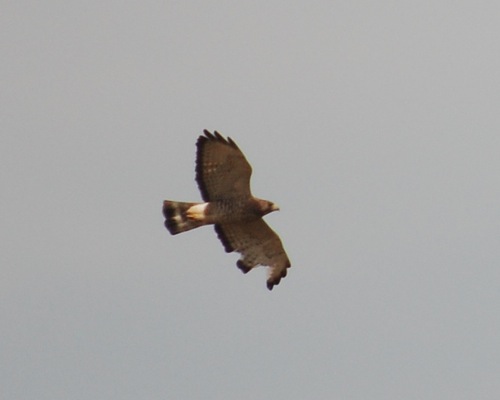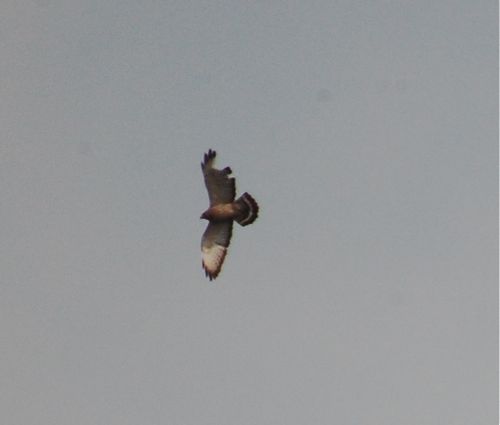Migration was in full spring today. It was a brown bird explosion which makes me so happy--new sparrows everywhere and this morning I was especially pleased to notice a small but steady stream of broad-winged hawks over our bee yard. I noticed the birds were fairly low and trying to get into thermals. I saw them close to the 10 am mark which made me wonder if this was a small flock that roosted nearby for the night and if this was a morning lift off?

One broad-winged hawk really stood out. Check out that right wing--it's almost as if something took a bite out of it. It's missing a chunk of primary and secondary wing feathers. I don't think this is a molting issue but not sure how it happend--altercation with a larger aerial predator? Attack from some South American predator over the winter? That's a significant chunk to lose on one wing and it must affect the bird's ability to soar and dive after prey.

As I was digiscoping this bird, I thought about how migration is hard enough, but to do it with a chunk of flight feathers missing must be a real bummer. However, the bird has made it this far, perhaps it is only going to the northern part of the state--they do breed here and it's journey may be almost over. As always, this is a testament to a wild bird's ability to survive in nature no matter what. Kind of puts those bad hair days into perspective.
In other interesting bird news Ryan Terrill posted a link to some photos on ID Frontiers of what appears to be a bilateral gynandromorphic black-throated blue warbler (ie: it looks male one on side, female on the other). As if warblers weren't hard enough--sheesh! The bird was banded recently in Jamaica. To make this even more interesting, last fall birdspot posted photos on Twitpic that she took in Central Park, NY of what appears to be a first year gynandromophic black-throated blue warbler seen here and here...is this the same bird? In both Ryan's photos and birdspot's photos the male and female parts seem to be on the same bird...
We have absolutely no way of knowing since it wasn't banded last fall, but it does bring up one intriguing possibility that it could be the same bird. Gynandromophia is unusual but so is refinding the same bird in a different country on migration.
